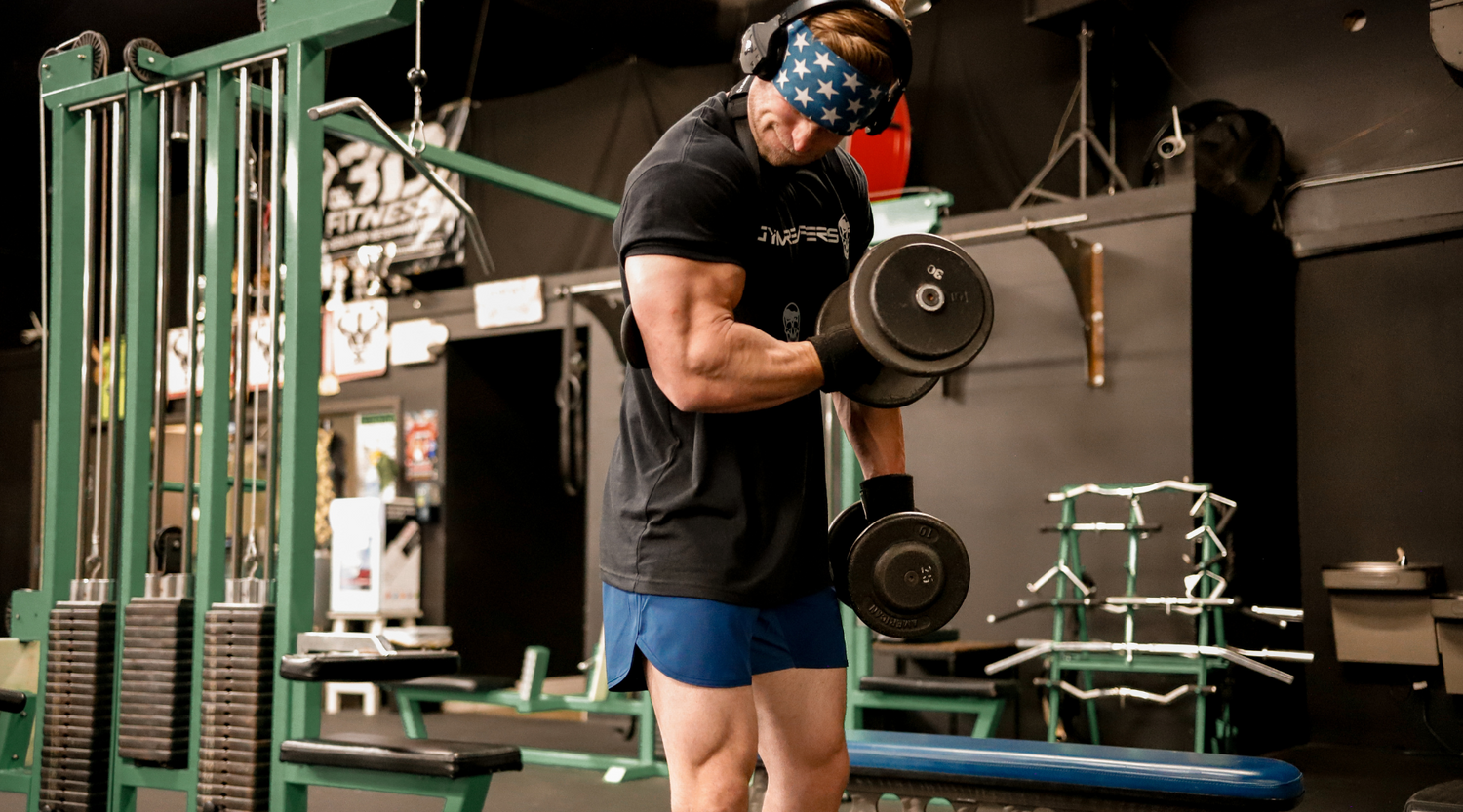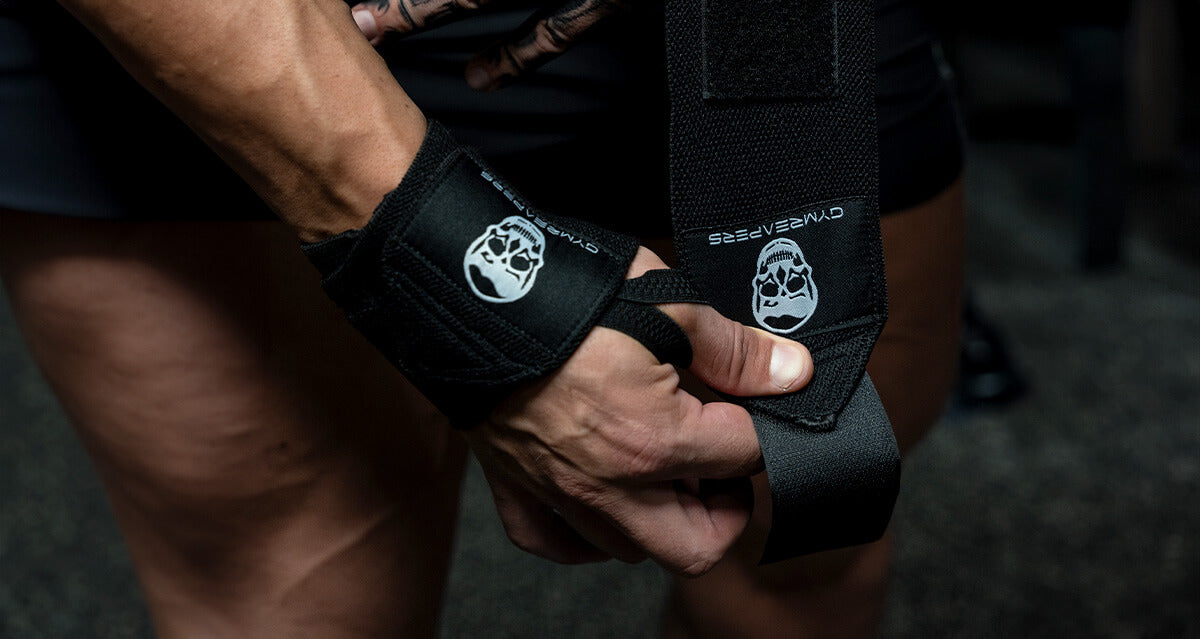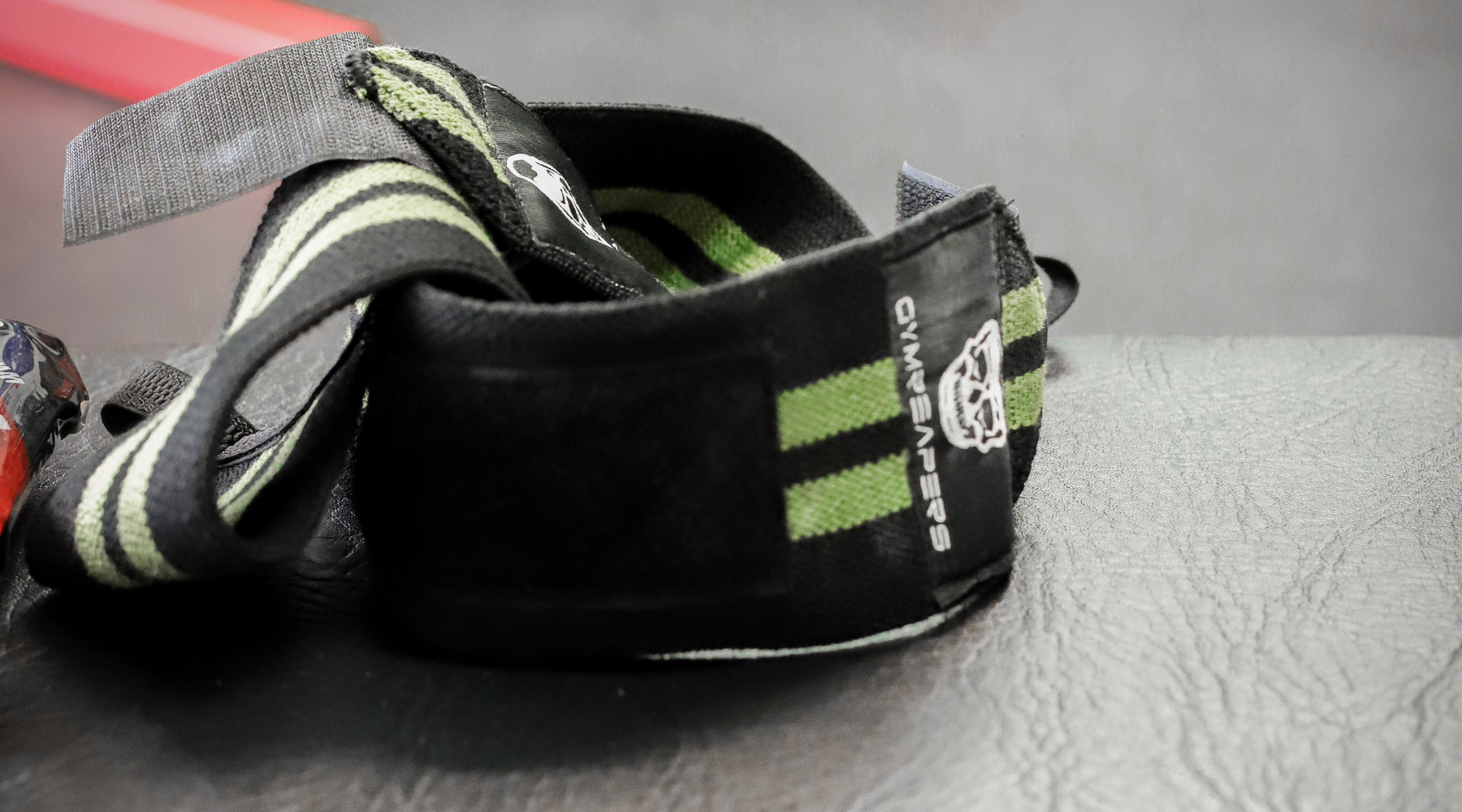Wearing wrist wraps is very common for lifters performing heavy compound movements like bench press or squats, but many lifters are beginning to wonder if they should be including wrist wraps in other bodybuilding-style lifts like bicep curls.
The answer? Wearing wrist wraps during bicep curls can be useful for most people.
Wrist wraps can provide your wrists with extra support, which improves stability, positioning, and rigidity in your wrist joint. This can help prevent injuries that stem from overuse or improper positioning, can help increase your performance by allowing you to better isolate the bicep, and can help alleviate prior issues with pain when curling.
Below, I will provide more detail on the benefits that can stem from wearing wrist wraps for curls and will provide tips on who should wear them and how to use them properly. I’ll also explain some of the negative outcomes if you wear them too much.
Key Takeaways
- Wrist wraps can alleviate stress on your wrist when curling, which can place the joint in a better position and reduce risk of injury over time.
- Avoid using the wraps as a crutch. Most underlying pain is caused by poor technique, an injury, or problems with flexibility or stability that should be addressed prior to wearing wrist wraps for curls.
- Make sure you wrap your wrist properly. Start just below the palm and don’t travel too far down your forearm. A wrist wrap should make it difficult to bend or flex your wrist while curling.
Should You Use Wrist Wraps For Curls?

As you may already know, wrist wraps are functional pieces of supportive strength gear for any lifter that wants additional wrist support when training.
Typically, we see lifters use them for any pressing movements (bench, dips, overhead press), but many lifters also use them for any other exercise that can put the wrists in strained positions, like squats.
Essentially, we see lifters wear wrist wraps in any exercise where they want to alleviate pressure on the wrist. So it makes sense to also wear wrist wrap for curls.
Pros Of Wearing Wrist Wraps For Curls
Form Support
The biggest benefit of wearing wrist wraps for any exercise is the wrist support that they provide.
When worn properly, wrist wraps can help to improve your stability and rigidity in your hand, wrist, and forearm area which can give you a much more stable base to lift with.
This is true for every exercise where the wrist is involved, which is essentially every free weight exercise, including curls.
Wrist strains are one of the most common weightlifting injuries.
As such, a wrap that can provide additional support to your wrists and help you keep proper alignment and form can be a great tool to reduce the risk of your form breaking down and causing you problems.
Protection
In addition to added support, wrist wraps can provide greater stability.
This stability decreases your risk of injury, since the wrist wrap can support all the muscles and connective tissue around your wrist, hand and forearm.
This then means that there is less of a chance for involuntary movement in your wrist, which can protect you from strains or other injuries due to overextending or overworking your wrist muscles.
Alleviation of Prior Issues
A huge pro of wrist wraps during curls is when they actually alleviate pain.
I know plenty of people that wrestle with soreness in their wrist from a prior injury, and it directly limits them when doing exercises like curls.
If you’re one of these people, and you find that the compression and stability from wrist wraps alleviates your pain when curling, that can be a huge benefit.
If this works for you, I obviously recommend implementing wrist wraps, but I will also caution you to avoid using them as a crutch.
Take some time to address the underlying issue, so that you can ideally do a curl pain-free even without wrist wraps.
Oftentimes, these prior pain issues can come from inflexible or weak wrists, poor form, or injuries that may need a medical professional to treat.
Wrist wraps can be a great tool and temporary fix, but addressing these underlying issues is a smart long-term move.
Performance
Wrist wraps have a great ability to increase performance in the muscles that you actually want to target when doing curls.

If you take out the risk of overextending or overworking your smaller wrist muscles by keeping your wrist in a more stable and secure position when doing curls, you can train the biceps much harder.
This is because you have taken out the weak link, very similar to how you can deadlift more when you wear straps and take out your grip as a limiting factor.
Similarly, by limiting the chance of wrist fatigue and injuries when doing curls, you can spend more effort focusing on your biceps.
This benefit is backed by research, which states that in addition to providing a more stable base to lift from, wrist wraps can help you generate more power and force when lifting weights due to the reduced energy leak coming from wrist instability and movement.
Cons Of Wearing Wrist Wraps For Curls
They Become a Crutch
Like any piece of supplemental strength equipment, if you wear wrist wraps too much, you can develop a reliance on them.
I will caution you against wearing wrist wraps all the time, for every exercise, regardless of the weight. If you have developed this much of a reliance upon them, there is a chance that your natural wrist strength and stability can decrease.
To avoid developing this type of reliance, I recommend doing as much work without wrist wraps as you can.
Personally, I would hit most warmups and non-challenging rep work without my wrist wraps, and only implement them for a top set, or when the set gets incredibly challenging and you would like to utilize their benefits.
They are a Hassle
A big con to wearing wrist wraps for curls is that they can quickly become a hassle for a variety of reasons.
The first hassle of wrist wraps for curls is that they are costly.
Wrist wraps can cost anywhere from $20 to $60+, and this can be quite a large sum of money if you do not already own them, or you are buying a pair solely for bicep curl.
Further, carrying wrist wraps around the gym can be quite annoying, as they are a fairly unwieldy piece of equipment.
You will quickly find yourself choosing between taking the time to roll them up, or carrying around loose long straps of fabric with velcro that can get caught on everything.
For athletes that use bring a gym bag on the floor, this is less of a con, but adding these to your items to carry around on arm-day can start to become a hassle.
A final reason that they can be a hassle is the time that they can add to your workout.
Wrist wraps take a good amount of time to take on and off, and this can really start to add up if you aim on using them for quite a few sets of curls.
This is a difficult problem to circumvent, as you really should not leave them on throughout your entire workout.
As I will discuss later, they should be tightened to the point of being mildly uncomfortable, and you cannot expect to put them on once and leave them for your whole session.
Uncomfortable
A final con to wrist wraps is that they may actually be quite uncomfortable for you while doing curls.
Maybe they irritate your skin, pinch your wrist joints, or you find them restricting your blood flow to the point of discomfort.
Whatever the reason, wrist wraps may not work for everyone when doing bicep curls, and this discomfort can be a massive con which may outweigh the benefits.
Who Should Wear Wrist Wraps For Curls

- I would recommend someone wear wrist wraps for anybody who has prior wrist pain, wants additional performance benefits on their heavy sets of curls, can use help with wrist stability, or thinks that they can get some long-term protective benefits should use wrist wraps for curls.
Who Shouldn’t Wear Wrist Wraps For Curls

- I don’t recommend people wear wrist wraps for curls if they experience discomfort from wearing wrist wraps. This is especially the case if you’re not getting any performance benefits and the wrist wraps are only causing pinching or skin irritation.
- People should also avoid wrist wraps for curls if they’re viewing them as a substitute for weak or immobile wrists because it means you are avoiding confronting the root of your problem.
- I also recommend not using wrist wraps if you work out under a time crunch, or only do moderately difficult sets of lighter weight.
4 Tips For Wearing Wrist Wraps For Curls

Choosing a Material and Style
Wrist wraps come in a variety of styles and materials.
Some are wider to support a full wrist, some are thinner to allow for a bit more flexibility, some are stiff and thick to essentially create a cast-like effect when lifting big weight, and some are more flexible to be more comfortable but compressive.
Additionally, wrist wraps can have different fastening mechanisms, with the most common being velcro.
As a powerlifter, I would typically recommend getting a longer, rigid, and very supportive wrist wrap that can provide maximum benefit when you are looking to squat or bench large amounts of weight.
However, this may not be the ideal style of wrist wrap for curls. If this style is all you have already, I would not recommend buying a new and different pair just for curls. The ones you own will do just fine.
If you are in the market for a new pair of wraps, and you want to use them predominantly for curls and other bodybuilding-style movements, then I would get a more flexible wrist wrap that is slightly more comfortable than a stiff wrap.
A great example would be the Gymreapers Wrist Wraps - 18” Weightlifting Wrist Support. They are 3 inches wide, and made of a nylon material that is 30% elastic and 70% polyester. They are long enough to provide sufficient wrist support, and are an excellent combination of durability and flexibility.
Position on Wrist

When wearing a wrist wrap for curls, avoid the common mistake of wrapping your wrist too low.
I recommend starting your wrist wrap just slightly below your palm and thumb joint, so that the edge of the wrap is at the base of your palm. Just be sure to give yourself room to grip the weight properly when getting set up for your curls.
This will increase the stability of your wrist joint by reducing your wrists ability to bend or flex at all during the lift.
Once you have set the wrap at the right height to begin, avoid wrapping too low down your forearm. Wrapping your lower arm will not provide any stability in your wrist, and it might just end up giving you a snake bite.
A good reference point is that, wherever you start your wrap near your palm, you should only go about 3-4 inches lower throughout the entire wrap job (just go past where you would wear a watch).
- Related Article: Should You Wear Wrist Wraps for Deadlifts? And, Do They Help?
Tightness of Wrap
There are two main mistakes that people make regarding tightness when wrapping their wrist.
The first is that their first revolution is too tight, and the second is that their wrist is in the wrong position when they begin the wrap job.
I always recommend progressively tightening your wrap job with each revolution. If you tighten your first revolution at 100%, you cannot make use of any of the stretch in the elastic and you will end up being incredibly uncomfortable.
Wrapping your first revolution at about 50-60% tightness, your second at about 75-90%, and your third at 100% tightness will maximize the stretch of the elasticity, get you great stability, and will still be relatively comfortable.
Regarding the second mistake, I recommend starting the wrap job with your hand and wrist flexing forward.
Having the wrist cocked forward when you start wrapping will make sure that, if you have any wrist mobility, it will only be forward. You will not get any unwanted backward flexion or instability in your wrist, which is usually what leads to pain or injury when doing curls.
You know that you have done this correctly when, after you have completed the wrap, you cannot bend your wrist backward as there will be way too much tension and support in the back of your wrist.
When to Put Them On
If you wrap your wrists with the tightness and placement considerations that I have just described, you will not be incredibly comfortable with your wraps on.
As such, you should only put your wrist wraps on before your more challenging sets of curls.
You shouldn’t feel a need to wear your wraps when warming up, or doing easier sets, and you absolutely should not keep your wraps on in between sets.
- Related Article: Do Wrist Wraps Help You Lift Heavier? (A Coach Answers)
Examples Of Top Athletes Using Wrist Wraps For Curls
Dan Green, 10x World-Record Setting Powerlifter
Here, we can see Dan Green, a 10x World-Record setting Powerlifter wearing wrist wraps for a set of straight bar, barbell bicep curls.
Chris Bumstead, Classic Physique Mr. Olympia x4
In contrast here, we can see Chris Bumstead not wearing wrist wraps while performing a set of dumbbell curls.
Frequently Asked Questions
Do You Need Wrist Wraps For Curls?
No, you don’t need wrist wraps for curls. However, they can help you alleviate existing pain, prevent injuries from overuse, provide greater wrist stability and support, and can help in your overall performance when used properly.
Why Does My Wrist Hurt While Curling Weights?
Most commonly, your wrists hurt during bicep curls because of improper wrist positioning. This can cause inflammation in your wrist due to the repetitive stress of curling over time. Otherwise, it can be a symptom of tendonitis, a strained muscle/tendon, or other more serious injuries.













Leave a comment
All comments are moderated before being published.
This site is protected by hCaptcha and the hCaptcha Privacy Policy and Terms of Service apply.